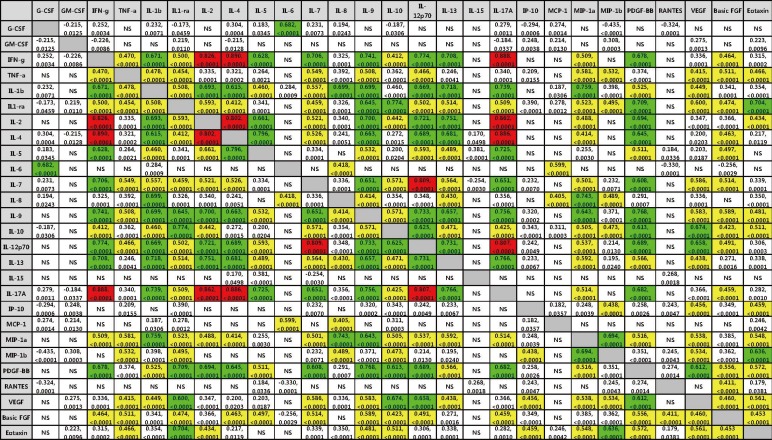Ann Lab Med.
2015 Jan;35(1):105-110. 10.3343/alm.2015.35.1.105.
Inflammatory Cytokines and Their Prognostic Ability in Cases of Major Burn Injury
- Affiliations
-
- 1Department of Burn Surgery, Hallym University Hangang Sacred Heart Hospital, Hallym University College of Medicine, Seoul, Korea.
- 2Department of Pediatrics, Hallym University Dongtan Sacred Heart Hospital, Hallym University College of Medicine, Hwaseong, Korea.
- 3Department of Laboratory Medicine, Hallym University Sacred Heart Hospital, Hallym University College of Medicine, Anyang, Korea.
- 4Department of Laboratory Medicine, Hallym University Dongtan Sacred Heart Hospital, Hallym University College of Medicine, Hwaseong, Korea. hskim0901@empas.com
- KMID: 2363156
- DOI: http://doi.org/10.3343/alm.2015.35.1.105
Abstract
- BACKGROUND
Major burn injuries induce inflammatory responses and changes in the levels of various cytokines. This study was conducted to assess early changes in the serum levels of inflammatory cytokines after burn injury, identify cytokines associated with mortality, and characterize correlations among cytokines.
METHODS
Blood samples of 67 burn patients were collected on days 1 and 3 after burn injury, and the concentrations of 27 cytokines were measured using the Bio-Plex Suspension Array System (Bio-Rad Laboratories, USA). Blood samples of 25 healthy subjects were used as controls. We analyzed statistical differences in the concentrations of each cytokine between the control and patient groups, between day 1 and day 3, and between survival and nonsurvival groups. Correlations among 27 cytokines were analyzed.
RESULTS
Median concentrations of granulocyte colony-stimulating factor (G-CSF), granulocyte macrophage colony-stimulating factor (GM-CSF), interleukin 1 receptor antagonist (IL-1RA), interleukin 6 (IL-6), interleukin 8 (IL-8), interleukin 10 (IL-10), interleukin 15 (IL-15), monocyte chemoattractant protein-1 (MCP-1), macrophage inflammatory protein 1beta (MIP-1beta), and vascular endothelial growth factor (VEGF) were significantly higher in burn patients than in controls. IL-1RA, IL-6, and MCP-1 levels were significantly higher in the nonsurvival group than in the survival group on day 1 after burn injury. Correlation analysis of 27 cytokines showed different relationships with one another. Stronger correlations among interferon gamma (IFN-gamma), IL-2, IL-4, IL-7, IL-12p70, and IL-17 were found.
CONCLUSIONS
IL-1RA, IL-6, and MCP-1 may be used as prognostic indicators of mortality in burn patients and the increase in cytokine concentrations is induced by interactions within a complex network of cytokine-related pathways.
Keyword
MeSH Terms
Figure
Reference
-
1. Finnerty CC, Herndon DN, Przkora R, Pereira CT, Oliveira HM, Queiroz DM, et al. Cytokine expression profile over time in severely burned pediatric patients. Shock. 2006; 26:13–19. PMID: 16783192.
Article2. Elias JA, Freundlich B, Kern JA, Rosenbloom J. Cytokine networks in the regulation of inflammation and fibrosis in the lung. Chest. 1990; 97:1439–1445. PMID: 2112081.
Article3. Ozaki K. Cytokine and cytokine receptor pleiotropy and redundancy. J Biol Chem. 2002; 277:29355–29358. PMID: 12072446.
Article4. Mikhal'chik EV, Piterskaya JA, Budkevich LY, Pen'kov LY, Facchiano A, De Luca C, et al. Comparative study of cytokine content in the plasma and wound exudate from children with severe burns. Bull Exp Biol Med. 2009; 148:771–775. PMID: 20396789.5. Jeschke MG, Gauglitz GG, Kulp GA, Finnerty CC, Williams FN, Kraft R, et al. Long-term persistence of the pathophysiologic response to severe burn injury. PLoS ONE. 2011; 6:e21245. PMID: 21789167.6. Davis CS, Janus SE, Mosier MJ, Carter SR, Gibbs JT, Ramirez L, et al. Inhalation injury severity and systemic immune perturbations in burned adults. Ann Surg. 2013; 257:1137–1146. PMID: 23160150.
Article7. Gauglitz GG, Finnerty CC, Herndon DN, Mlcak RP, Jeschke MG. Are serum cytokines early predictors for the outcome of burn patients with inhalation injuries who do not survive? Crit Care. 2008; 12:R81. PMID: 18564432.
Article8. Csontos C, Foldi V, Pálenkas L, Bogar L, Röth E, Weber G, et al. Time course of pro- and anti-inflammatory cytokine levels in patients with burns-prognostic value of interleukin-10. Burns. 2010; 36:483–494. PMID: 20045261.
Article9. Kim HS, Kim JH, Yim H, Kim D. Changes in the levels of interleukins 6, 8, and 10, tumor necrosis factor alpha, and granulocyte-colony stimulating factor in Korean burn patients: relation to burn size and postburntime. Ann Lab Med. 2012; 32:339–344. PMID: 22950069.10. Finnerty CC, Jeschke MG, Herndon DN, Gamelli R, Gibran N, Klein M, et al. Temporal cytokine profiles in severely burned patients: a comparison of adults and children. Mol Med. 2008; 14:553–560. PMID: 18548133.
Article11. Lantos J, Földi V, Roth E, Wéber G, Bogár L, Csontos C. Burn trauma induces early HMGB1 release in patients: its correlation with cytokines. Shock. 2010; 33:562–567. PMID: 19997053.
- Full Text Links
- Actions
-
Cited
- CITED
-
- Close
- Share
- Similar articles
-
- Changes in the Levels of Interleukins 6, 8, and 10, Tumor Necrosis Factor Alpha, and Granulocyte-colony Stimulating Factor in Korean Burn Patients: Relation to Burn Size and Postburn Time
- The Effect of Early Escharectomy on Pro- and Antiinflammatory Cytokines in Major Burn Patients
- A Case of Pregnancy after Burn Injury
- Clinical and Epidemiological Characteristics of Admitted Burn Patients and Analysis of Prognostic Factors
- A Case of Crushing Burn Injury: A Case Report


